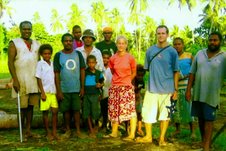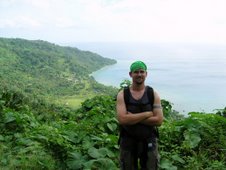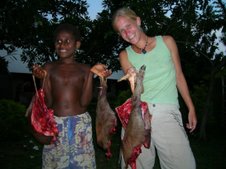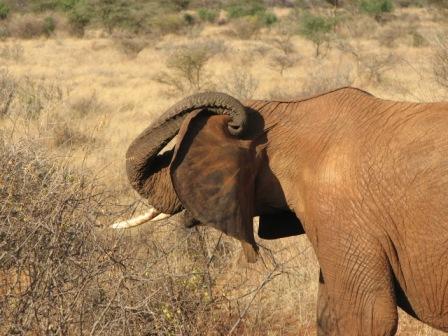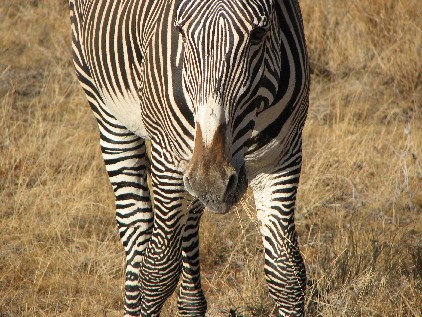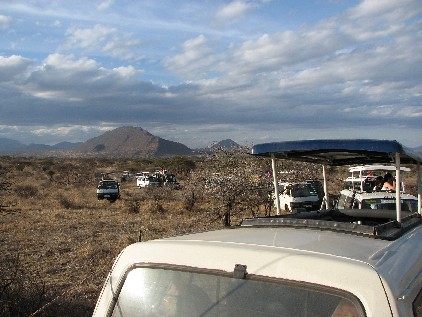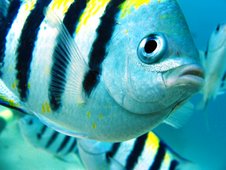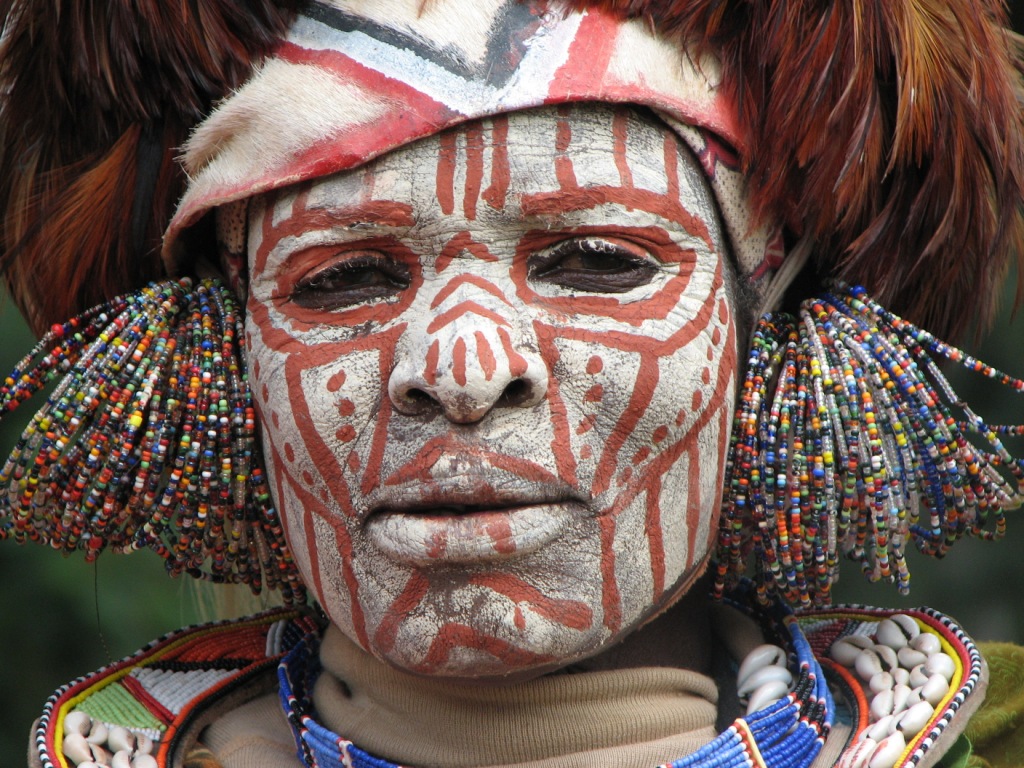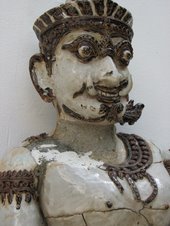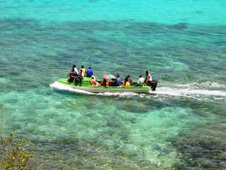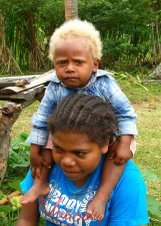 We continued heading south in Uganda, the land of rolling hills and crater lakes, to the famed and beautiful Lake Bunyonyi. Lake Bunyonyi is a large lake with 29 small islands which historically where not islands at all but the tops of hills found in the mountainous area which forms the border between Rwanda and Uganda. The area, once a riverine wetland, was altered when a volcanic eruption blocked the outflow and flooded the valley areas creating a network of "islands" within this new "lake." The lake itself lies at 1,962 meters above sea level and is about 25 kilometers by 7 kilometers wide. Average depth is a bit murky (as is the water), but is "guess-timated" at anywhere from 44 to 900 meters. Most of the islands have been occupied for the last 200 years, at least intermittently, and this is visually evident by the intensely cultivated and terraced slopes that are present on all the islands. In the local dialect Bunyonyi roughly translates into "Place of many small birds." Given the ornithological inclinations of my husband I wondered would this place translate for me as "Place where the husbands go missing?"
We continued heading south in Uganda, the land of rolling hills and crater lakes, to the famed and beautiful Lake Bunyonyi. Lake Bunyonyi is a large lake with 29 small islands which historically where not islands at all but the tops of hills found in the mountainous area which forms the border between Rwanda and Uganda. The area, once a riverine wetland, was altered when a volcanic eruption blocked the outflow and flooded the valley areas creating a network of "islands" within this new "lake." The lake itself lies at 1,962 meters above sea level and is about 25 kilometers by 7 kilometers wide. Average depth is a bit murky (as is the water), but is "guess-timated" at anywhere from 44 to 900 meters. Most of the islands have been occupied for the last 200 years, at least intermittently, and this is visually evident by the intensely cultivated and terraced slopes that are present on all the islands. In the local dialect Bunyonyi roughly translates into "Place of many small birds." Given the ornithological inclinations of my husband I wondered would this place translate for me as "Place where the husbands go missing?" We decided to join a canoe trekking trip, a new tourism venture only offered once a month by the a group called Edrisa. I don't know exactly how to describe Edrisa, it seems a conglomerate of various efforts, the group has a guest house in Kabale, volunteer positions in education with a Bunyonyi's primary school, some fair trade projects and other various projects to help surrounding communities. It is an NGO that has taken the a self-efficient look at the bottom line and set itself up with profitable business ventures to sustainably fund their charitable efforts. For them, not depending on handouts and fickle grants and funds means that the schools and programs they are funding have a stability that many lack. It really is an interesting venture and I would encourage you to check it out on the web at http://www.edirisa.org. (Photograph is Benjamin and Warren tour manager for Edirisa overlooking Kabale) In addition to providing an amazing service to the peoples of southern Uganda, the primary school they took over has gone from one of the poorest and worst performing to the third best in the district, they provide a great service to consumers as well. The canoe trek was amazing, off the beaten track and we got a chance to stay with local families, dine on local cuisine (goat and matooke anyone?) and throw back a couple thick gulps of "sorghum porridge." But I am getting a bit ahead of myself.....
We decided to join a canoe trekking trip, a new tourism venture only offered once a month by the a group called Edrisa. I don't know exactly how to describe Edrisa, it seems a conglomerate of various efforts, the group has a guest house in Kabale, volunteer positions in education with a Bunyonyi's primary school, some fair trade projects and other various projects to help surrounding communities. It is an NGO that has taken the a self-efficient look at the bottom line and set itself up with profitable business ventures to sustainably fund their charitable efforts. For them, not depending on handouts and fickle grants and funds means that the schools and programs they are funding have a stability that many lack. It really is an interesting venture and I would encourage you to check it out on the web at http://www.edirisa.org. (Photograph is Benjamin and Warren tour manager for Edirisa overlooking Kabale) In addition to providing an amazing service to the peoples of southern Uganda, the primary school they took over has gone from one of the poorest and worst performing to the third best in the district, they provide a great service to consumers as well. The canoe trek was amazing, off the beaten track and we got a chance to stay with local families, dine on local cuisine (goat and matooke anyone?) and throw back a couple thick gulps of "sorghum porridge." But I am getting a bit ahead of myself.....The canoe trek itself started on August 24th and ended on the 26th... so it was a very interesting
 way for me to turn 28, our madden voyage on the dugout canoes into the terraced hills of southern Uganda. We packed small bags, and meeting up with seven other participants (all of them volunteers for one agency or another in Uganda) we headed up to "The heart of Edirisa" a small primary school where we would launch our canoes and begin a trek into what has been called the most beautiful of the crater lakes in southern Uganda. If Churchill called Uganda his "pearl," Lake Bunyonyi proved to be the "mother of pearl." The children at Edirisa performed several dances, keeping rhythm on a cattle-hide drum, the boys and girls both shy, with eyes wondering to avoid looking at the spectators, and ebullient at the same time. I have no photographs although it is one of the most powerful images in my mind of east Africa. After the performance we loaded the long dugout canoes, able to easily accommodate five people and supplies, and headed into a lake of both "small birds" and rich human history.
way for me to turn 28, our madden voyage on the dugout canoes into the terraced hills of southern Uganda. We packed small bags, and meeting up with seven other participants (all of them volunteers for one agency or another in Uganda) we headed up to "The heart of Edirisa" a small primary school where we would launch our canoes and begin a trek into what has been called the most beautiful of the crater lakes in southern Uganda. If Churchill called Uganda his "pearl," Lake Bunyonyi proved to be the "mother of pearl." The children at Edirisa performed several dances, keeping rhythm on a cattle-hide drum, the boys and girls both shy, with eyes wondering to avoid looking at the spectators, and ebullient at the same time. I have no photographs although it is one of the most powerful images in my mind of east Africa. After the performance we loaded the long dugout canoes, able to easily accommodate five people and supplies, and headed into a lake of both "small birds" and rich human history. We paddled our canoes, the best one can when almost everyone but the guide is already snapping photographs, heading towards Bushara Island where yes indeed, we grabbed a beverage and saw some small birds. Warren our guide was very knowledgeable and we walked around the small island as he showed us some medicinal plants used by many southern Ugandans. Some plants had some very practical applications including leaves that when eaten would suppress hunger, very practical for many pastoralists away to graze cattle for long periods of time, in addition to one plant used by pubescent girls to "develop" or enhance and elongate a certain private part in their nether-regions.....hmm. (Warren's entrepreneur kicked in as he questioned the girls in the group about its potential for marketing in western countries...enough said.)
We paddled our canoes, the best one can when almost everyone but the guide is already snapping photographs, heading towards Bushara Island where yes indeed, we grabbed a beverage and saw some small birds. Warren our guide was very knowledgeable and we walked around the small island as he showed us some medicinal plants used by many southern Ugandans. Some plants had some very practical applications including leaves that when eaten would suppress hunger, very practical for many pastoralists away to graze cattle for long periods of time, in addition to one plant used by pubescent girls to "develop" or enhance and elongate a certain private part in their nether-regions.....hmm. (Warren's entrepreneur kicked in as he questioned the girls in the group about its potential for marketing in western countries...enough said.)
We also saw the infamous Akampene or "Punishment Island," a small jejune island with only one tree, where pregnant unmarried girls used to be dumped off to die as punishment for their iniquity. We were told that the girls would usually drown trying to swim to another island (as many Africans-even those living on a lake-don't know how to swim) and it was particularly gruesome because sometimes the girls would also grab their brothers or fathers, as they tried to dump them off, and several members of the family would perish. The girls only hope was that a poor young farmer, without the cattle or bride price to marry, would come and "rescue" the girl to become a free bride. The practice was only abandoned in the mid 1900's when it became seen as a bit draconian.
 After the unnerving tales of Akampene we headed to a much larger island called Bwama island, where the famous Ugandan cattle, some of which would make a Texas longhorn blush, greeted us. The island was "depopulated" when a Scottish physician set up a Leprosy Treatment Center in 1921. At its height the clinic housed 5,000 patients from all over East Africa and remained open until the 1980s when a drug was developed and patients no longer needed isolation to prevent spread. Now the a few villagers have returned and the well grounds have been converted into a boarding school for primary and secondary students in the area. School was out of session during our visitation, leaving way more cattle than people on this island.
After the unnerving tales of Akampene we headed to a much larger island called Bwama island, where the famous Ugandan cattle, some of which would make a Texas longhorn blush, greeted us. The island was "depopulated" when a Scottish physician set up a Leprosy Treatment Center in 1921. At its height the clinic housed 5,000 patients from all over East Africa and remained open until the 1980s when a drug was developed and patients no longer needed isolation to prevent spread. Now the a few villagers have returned and the well grounds have been converted into a boarding school for primary and secondary students in the area. School was out of session during our visitation, leaving way more cattle than people on this island.We continued on our way and reached our final destination after some of the group took advantage of swimming in the bilharzia free waters under the watchful eye of a local group of children. Our hostess greeted us with genuine enthusiasm and pulled me up a steep embankment and locked me up in a bear-hug leaving my feet dangling and head pressed against her colorful kanga. Not a single person in the family spoke English or Swahili. Our group went about setting up tents among the scores of interested children, adolescents and goats, while our hosts went about fixing dinner. Foreigners or "mzungus" are still of great interest to the children and they were transfixed by their pallid visitors  and particularly digital cameras. We all climbed a steep hill to view the school/ church grounds that was providing primary education to over 200 students. The teacher, one of only 3 or 4, was explaining the dilapidated conditions and struggle that the community has in providing the children with education. Many times, he said, the overcrowded and hot class rooms must move under the mango tree to conduct classes. Certainly not an ideal situation but I also told him that well trained teachers can teach and inspire students in any situation and locally built infrastructure does not mean inferior education. How teacher
and particularly digital cameras. We all climbed a steep hill to view the school/ church grounds that was providing primary education to over 200 students. The teacher, one of only 3 or 4, was explaining the dilapidated conditions and struggle that the community has in providing the children with education. Many times, he said, the overcrowded and hot class rooms must move under the mango tree to conduct classes. Certainly not an ideal situation but I also told him that well trained teachers can teach and inspire students in any situation and locally built infrastructure does not mean inferior education. How teacher s can deal with 50-60+ children is an entirely different issue. We descending the steep gradient towards the house to ready for a filling meal including goat, sweet potato and porridge. The host family asked me to snap a photograph of their family, three generations, and I hurried to set up the shot as the sun drowned behind us. They were incredibly generous people and my only regret was the sizable language barrier which left most of us with crude gestures and dependent on our guides to translate.
s can deal with 50-60+ children is an entirely different issue. We descending the steep gradient towards the house to ready for a filling meal including goat, sweet potato and porridge. The host family asked me to snap a photograph of their family, three generations, and I hurried to set up the shot as the sun drowned behind us. They were incredibly generous people and my only regret was the sizable language barrier which left most of us with crude gestures and dependent on our guides to translate.
 and particularly digital cameras. We all climbed a steep hill to view the school/ church grounds that was providing primary education to over 200 students. The teacher, one of only 3 or 4, was explaining the dilapidated conditions and struggle that the community has in providing the children with education. Many times, he said, the overcrowded and hot class rooms must move under the mango tree to conduct classes. Certainly not an ideal situation but I also told him that well trained teachers can teach and inspire students in any situation and locally built infrastructure does not mean inferior education. How teacher
and particularly digital cameras. We all climbed a steep hill to view the school/ church grounds that was providing primary education to over 200 students. The teacher, one of only 3 or 4, was explaining the dilapidated conditions and struggle that the community has in providing the children with education. Many times, he said, the overcrowded and hot class rooms must move under the mango tree to conduct classes. Certainly not an ideal situation but I also told him that well trained teachers can teach and inspire students in any situation and locally built infrastructure does not mean inferior education. How teacher s can deal with 50-60+ children is an entirely different issue. We descending the steep gradient towards the house to ready for a filling meal including goat, sweet potato and porridge. The host family asked me to snap a photograph of their family, three generations, and I hurried to set up the shot as the sun drowned behind us. They were incredibly generous people and my only regret was the sizable language barrier which left most of us with crude gestures and dependent on our guides to translate.
s can deal with 50-60+ children is an entirely different issue. We descending the steep gradient towards the house to ready for a filling meal including goat, sweet potato and porridge. The host family asked me to snap a photograph of their family, three generations, and I hurried to set up the shot as the sun drowned behind us. They were incredibly generous people and my only regret was the sizable language barrier which left most of us with crude gestures and dependent on our guides to translate.  The next day we embarked on a full day trek up to the highest peak in the area, Karembe (mountain? hill?....felt more like mountain) which is about 8,130 feet above see level. Up was of the fast and furious venture, the steep rocky path overlooking the border with Rwanda. The area is inhabited by several tribes, the most famous are the Batwa tribe (also known as "pygmies") and lesser known Bakiga. Our guides explained to us how many Bakiga benefited during the genocides in Rwanda by subjugating the Batwa to carry goods raided from the abandoned gardens and forests over the hill. The Batwa, however short their stature, are renowned as being exceptionally strong and able to carry 100 kilograms for long distances. We saw several Batwa men carrying bags filled with agricultural products that looked twice their size and it became little wonder that these people have been exploited as porters. As we reached the top and crossed the hill, the views were as breathtaking as the climb.
The next day we embarked on a full day trek up to the highest peak in the area, Karembe (mountain? hill?....felt more like mountain) which is about 8,130 feet above see level. Up was of the fast and furious venture, the steep rocky path overlooking the border with Rwanda. The area is inhabited by several tribes, the most famous are the Batwa tribe (also known as "pygmies") and lesser known Bakiga. Our guides explained to us how many Bakiga benefited during the genocides in Rwanda by subjugating the Batwa to carry goods raided from the abandoned gardens and forests over the hill. The Batwa, however short their stature, are renowned as being exceptionally strong and able to carry 100 kilograms for long distances. We saw several Batwa men carrying bags filled with agricultural products that looked twice their size and it became little wonder that these people have been exploited as porters. As we reached the top and crossed the hill, the views were as breathtaking as the climb.We had lunch at the top of the hill with a commanding view of the terraced  islands of Lake Bunyonyi. We also could see Mt.Muhabura, one of the extinct volcanoes of the Varunga mountain range in Rwanda. We finished our lunch and proceeded to "relax" atop the bald hill, void of all shade, chatting and enjoying the beautiful view. Unfortunately this proved problematic latter on as our group began feeling parched and greedily consumed our water supply with several kilometers left to go. The day became long, hot and dusty. The villagers still regarding us with curiosity send children yelling, "Mzungu! Mzungu!" and toddlers crying. Once interesting stop resulted in an impromptu dancing and singing session. It was amazing but all most of the sun-burnt mzungu could do was watch with interest clinging to the few thorn-clad bushes which provided sparse shade. The descent was my least favorite part, long and gruelling it felt as if we would never reach the lake shore again. Once we did, our group had actually broke a record and arrived early which equated to the boats not being at shore. Nearby, Habukomi island was to be our sleeping grounds for the night. Inhabited by just one family, the Edirisa staff had taken the gear earlier that morning and where still on the island. As we waited we watched many of the lake's bird species heading for their night roost. It was a sanguine end to a wonderful yet challenging day.
islands of Lake Bunyonyi. We also could see Mt.Muhabura, one of the extinct volcanoes of the Varunga mountain range in Rwanda. We finished our lunch and proceeded to "relax" atop the bald hill, void of all shade, chatting and enjoying the beautiful view. Unfortunately this proved problematic latter on as our group began feeling parched and greedily consumed our water supply with several kilometers left to go. The day became long, hot and dusty. The villagers still regarding us with curiosity send children yelling, "Mzungu! Mzungu!" and toddlers crying. Once interesting stop resulted in an impromptu dancing and singing session. It was amazing but all most of the sun-burnt mzungu could do was watch with interest clinging to the few thorn-clad bushes which provided sparse shade. The descent was my least favorite part, long and gruelling it felt as if we would never reach the lake shore again. Once we did, our group had actually broke a record and arrived early which equated to the boats not being at shore. Nearby, Habukomi island was to be our sleeping grounds for the night. Inhabited by just one family, the Edirisa staff had taken the gear earlier that morning and where still on the island. As we waited we watched many of the lake's bird species heading for their night roost. It was a sanguine end to a wonderful yet challenging day.
 islands of Lake Bunyonyi. We also could see Mt.Muhabura, one of the extinct volcanoes of the Varunga mountain range in Rwanda. We finished our lunch and proceeded to "relax" atop the bald hill, void of all shade, chatting and enjoying the beautiful view. Unfortunately this proved problematic latter on as our group began feeling parched and greedily consumed our water supply with several kilometers left to go. The day became long, hot and dusty. The villagers still regarding us with curiosity send children yelling, "Mzungu! Mzungu!" and toddlers crying. Once interesting stop resulted in an impromptu dancing and singing session. It was amazing but all most of the sun-burnt mzungu could do was watch with interest clinging to the few thorn-clad bushes which provided sparse shade. The descent was my least favorite part, long and gruelling it felt as if we would never reach the lake shore again. Once we did, our group had actually broke a record and arrived early which equated to the boats not being at shore. Nearby, Habukomi island was to be our sleeping grounds for the night. Inhabited by just one family, the Edirisa staff had taken the gear earlier that morning and where still on the island. As we waited we watched many of the lake's bird species heading for their night roost. It was a sanguine end to a wonderful yet challenging day.
islands of Lake Bunyonyi. We also could see Mt.Muhabura, one of the extinct volcanoes of the Varunga mountain range in Rwanda. We finished our lunch and proceeded to "relax" atop the bald hill, void of all shade, chatting and enjoying the beautiful view. Unfortunately this proved problematic latter on as our group began feeling parched and greedily consumed our water supply with several kilometers left to go. The day became long, hot and dusty. The villagers still regarding us with curiosity send children yelling, "Mzungu! Mzungu!" and toddlers crying. Once interesting stop resulted in an impromptu dancing and singing session. It was amazing but all most of the sun-burnt mzungu could do was watch with interest clinging to the few thorn-clad bushes which provided sparse shade. The descent was my least favorite part, long and gruelling it felt as if we would never reach the lake shore again. Once we did, our group had actually broke a record and arrived early which equated to the boats not being at shore. Nearby, Habukomi island was to be our sleeping grounds for the night. Inhabited by just one family, the Edirisa staff had taken the gear earlier that morning and where still on the island. As we waited we watched many of the lake's bird species heading for their night roost. It was a sanguine end to a wonderful yet challenging day.Arriving on the island at night we saw that the human population was surpassed, at night, by the African crown-crane population. These regal birds were roosting in the trees and walking around the manicured grazing grounds for the few livestock on the island. Sorghum, goats, small crops (maize) and one homestead was the sole evidence of human habitation. We pitched our tents, ate our goat and motoke, swigs of fermented sorghum, our tired bones went to sleep for the night. Our last day we woke early, summited the small isle and were greeted by a green mamba (very poisonous snake) which, sleek and without malice or hesitation, exited the accidental human corral smoothly and at close proximity to our fellow travelers. We continued on canoes, to an island set up for those who wanted a bit more comfort than a tent and had an amazing meal. The group talked, non-stop almost creating a white noise of human laughter and bird-like chatter, the beer was good (cold) and the food was amazing. The birds were abundant and we even spotted an otter. An amazing trip, great company and one more reason why Uganda is truly a hidden treasure in East Africa.
-Jessica (firmly in her late 20's)










































